30 Years Ago: The Oil Pollution Act of 1990
The Oil Pollution Act of 1990 significantly improved measures to prevent, prepare for, and respond to oil spills in U.S. waters. This historic legislation gives NOAA and other agencies the authority to address impacts to natural resources caused by oil spills in U.S. waters and shorelines, and to hold polluters accountable.
Thanks to improved measures put in place to prevent oil spills, large spills such as Exxon Valdez and Deepwater Horizon are few and far between. But not too long ago, large spills happend with a much greater frequency. In the year leading up to the passage of the Oil Pollution Act there were a number of spills that served as a backdrop during the bill's journey into becoming a law.
March 16, 1989 | H.R. 1465 introduced.
The Oil Pollution Act of 1990 was introduced into the legislative process for enactment on March 16, 1989. It was sponsored by Rep. Walter B. Jones, D-NC.
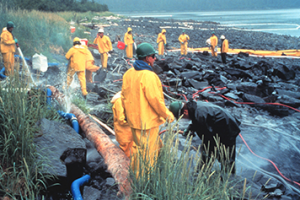
March 24, 1989 | Exxon Valdez Oil Spill.
On March 24, 1989, the Exxon Valdez oil tanker spilled almost 11 million gallons of oil into relatively pristine Alaskan waters. It was America's largest oil spill at the time, and is largely credited with inspiring the passage of the Oil Pollution Act.
Image credit: Exxon Valdez Oil Spill Trustee Council.
April 4, 1989 | S.686 introduced.
The Oil Pollution Liability and Compensation Act of 1989 was introduced into the Senate by Sen. George J. Mitchell, D-ME on April 4, 1989. It was later incorporated into H.R. 1465 as an amendment to the Oil Pollution Act.
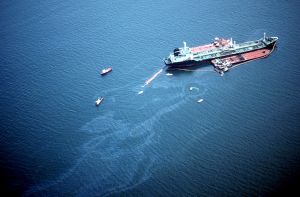
June 23, 1989 | World Prodigy Oil Spill.
On June 23, 1989, the Greek tank ship World Prodigy struck Brenton Reef near Narragansett Bay, about 4 miles south of Newport, Rhode Island. The vessel was loaded with 8.2 million gallons (over 195,000 barrels) of No. 2 home heating oil. The grounding tore a 200-foot gash in the hull of the ship and released 290,000 gallons of No. 2 fuel oil into the Rhode Island Sound.
Image credit: Eric Gundlach, Research Planning Inc.
June 24, 1989 | Presidente Rivera Oil Spill.
On June 24, 1989 the Uruguayan motor vessel Presidente Rivera ran aground in the Delaware River near Claymont, Delaware. Approximately 307,000 gallons of No. 6 oil were released, contaminating the riverbanks of Pennsylvania, New Jersey, and Delaware for approximately 30 miles.
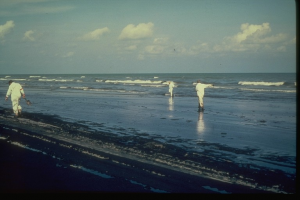
June 24, 1989 | Coastal 2514 Oil Spill.
On June 24, 1989 the T/S Rachel B and T/B Coastal Towing 2514 collided near the junction of the Houston Ship Channel and the Bay Port Ship Channel in Galveston Bay. The Coastal was reported to be carrying around 6,000 barrels of slurry oil in three tanks. All three tanks were damaged, and 250,000 gallons spilled into Galveston Bay.
September 10, 1989 | Hurricane Hugo.
During the devastation of Hurricane Hugo, which ran its course from Sept. 10-25 in 1989, 1.1 million gallons of thick fuel oil released from a shore-side facility in the U.S. Virgin Islands.
November 9, 1989 | Passes by the House.
The House passed the bill onto the Senate on Nov. 9, 1989 with a vote of 375-5.
November 15, 1989 | Milos Reefer Oil Spill.
The fishing vessel Milos Reefer grounded on the northeast corner of St. Matthew Island, Alaska, spilling approximately 237,343 gallons of intermediate fuel oil and diesel into the Bering Sea.
Image credit: Alaska Department of Environmental Conservation.
November 19, 1989 | Passed by Senate with Amendment.
The Senate passed the bill with revisions, including an amendment incorporating S. 686, the Oil Pollution Liability and Compensation Act of 1989. The House did not agree to the revisions.
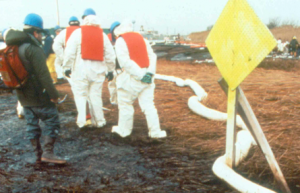
January 1, 1990 | Exxon Bayway Oil Spill.
From Jan. 1-2, 1990, 567,000 gallons of heating oil leaked into the Arthur Kill waterway between New Jersey and Staten Island after a pipeline ruptured in Exxon’s Bayway refinery in Linden, New Jersey.
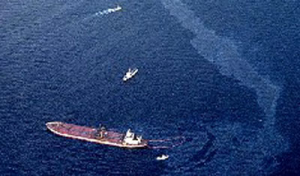
February 7, 1990 | American Trader Oil Spill.
The oil tanker American Trader ran over its anchor, puncturing its hull and spilling an estimated 416,598 gallons of crude oil near Huntington Beach, California.
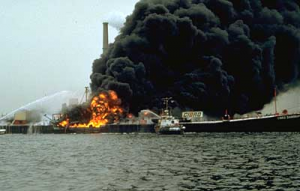
March 6, 1990 | Cibro Savannah Oil Spill.
The barge Cibro Savannah exploded and caught fire while departing a pier in Linden, New Jersey on March 6, 1990, spilling 700,000 gallons into the Arthur Kill waterway.
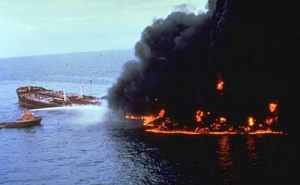
June 28, 1990 | Mega Borg Oil Spill.
The Mega Borg released 5.1 million gallons of oil into the Gulf of Mexico, 60 offshore from Galveston, Texas, after a lightering accident and subsequent fire.
July 28, 1990 | Apex Barges Oil Spills.
The Greek Tank Vessel, Shinoussa, collided with Apex tank barges carrying oil in the Houston Ship Channel. At least 700,000 gallons of partially refined crude oil were discharged from two of the damaged barges—impacting shorelines, birds, emergent marsh, and aquatic resources.
August 18, 1990 | The Oil Pollution Act of 1990 becomes a law.
After a unanimous vote in both the Senate (99-0) and the House (360-0), President George H.W. Bush signed the Oil Pollution Act of 1990 into law on Aug. 18, 1990.
 An official website of the United States government.
An official website of the United States government. 